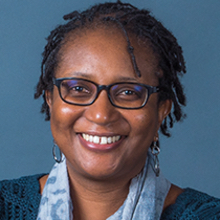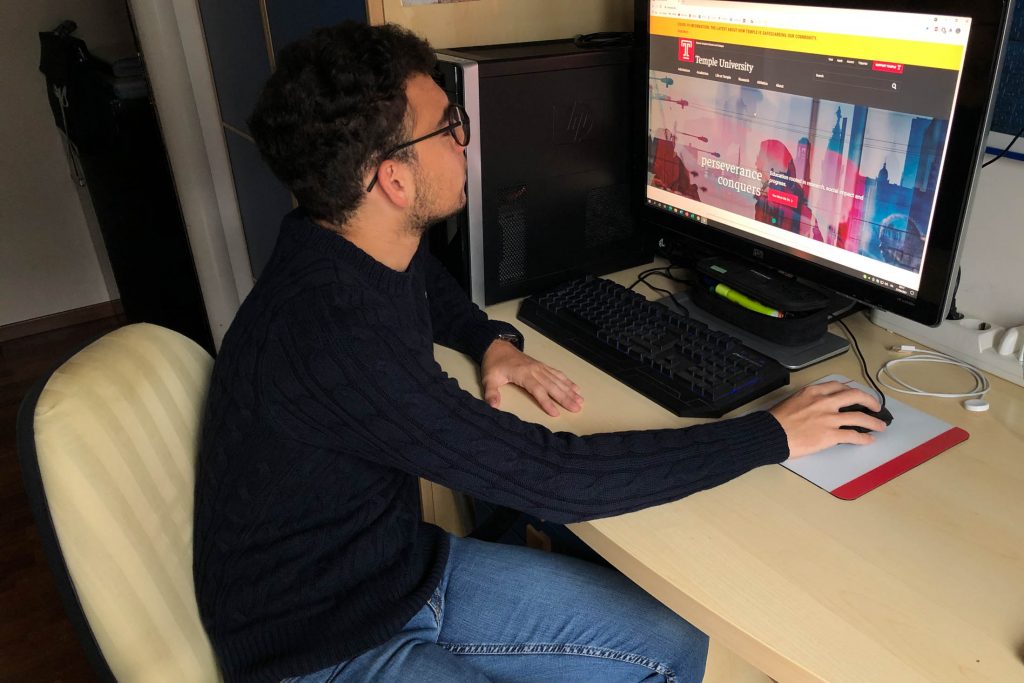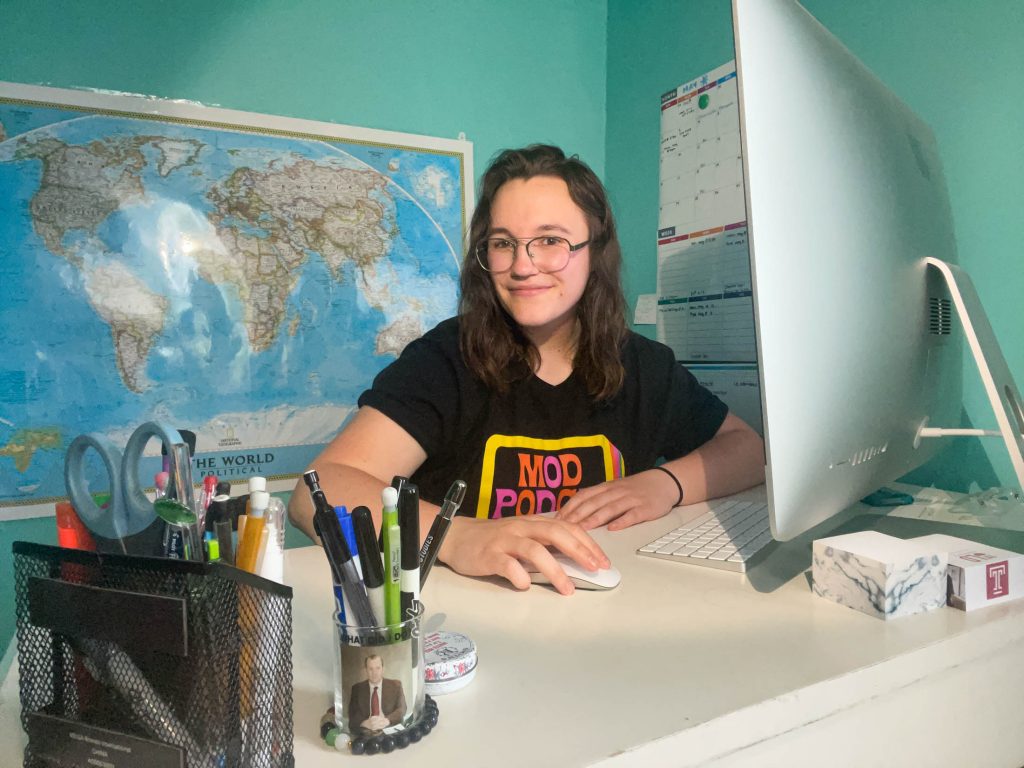Although Libby Tarquinio purchased a $3,000 desktop computer to edit videos for her film classes, a year of online learning cost her much more: missed time with peers and teachers, hands-on learning opportunities and a chance to study away in Los Angeles.
“I haven’t been able to work on sets that have been going on or you know, get all those classroom experiences that I’ve paid for,” said Tarquinio, a senior film and media arts major. “I lost that, and there’s no way for me to get that back.”
During a full academic year of online learning during the COVID-19 pandemic, Temple University students adapted their spaces, routines and learning styles by purchasing new technology and equipment and converting their homes into classrooms in the fall 2020 and spring 2021 semesters. But for many, the cost of virtual learning was most prominent in what they lost, from less access to physical campus resources, to being separated from other students and instructors.
Temple initially shifted its classes online on March 11, 2020, at the onset of the COVID-19 pandemic. In the following academic year, which would be almost completely online, the university held many classes in person for the first week of the fall 2020 semester but pivoted virtually on Sept. 4, 2020, as COVID-19 cases at Temple rose to 212. For the spring 2021 semester, Temple held a hybrid mix of mostly virtual classes and some in-person.
Online classes at Temple are held either synchronously, with scheduled classes held on Zoom, or asynchronously, with no scheduled classes but regular assignments on Canvas.
These Zoom classes became the norm for many Temple students this year. But with users’ ability to mute their audio and turn off their cameras, some classes consisted of staring at blank boxes and listening to a disembodied voice, and the disconnect between peers and with instructors grew ever-larger.
Throughout this time, most students likely have accessed a computer to complete their course work either by owning one, borrowing one or using Temple’s resources, like the TECH Center, said Will Jordan, a policy, organizational and leadership studies professor. Many faculty members have also had training on using educational technology and teaching online courses.

Dr. Will Jordan. (Photo via LinkedIn)
Despite this, students and faculty in online classes still struggled with communication, like speaking on Zoom or using the chat function during class, Jordan said.
In an undergraduate course he taught in fall 2020, an estimated 15 to 20% of students had their cameras on and engaged fully, Jordan said. The class, which was based more on the dialogue between students than lectures, was filled with black screens.
“I see education as being an intensely human enterprise — you know, people talk, students raise their hands, they ask questions, they interject, you can read the room, you can look around the classroom and see that your class has no idea what you’re talking about, and it’s obvious when you’re in front of the classroom doing it,” Jordan said over Zoom, laughing. “On Zoom, it’s really hard.”
Around 4,500 students took in-person classes that required hands-on learning, like performance, ensemble and laboratory classes, throughout the fall 2020 semester. Classes like these that were “never really meant to be online” aren’t easily replicated on Zoom, Jordan said.
Tarquinio went through the complication of transferring some classes online while enrolled in the Los Angeles Study Away program, where students take entertainment industry classes and get hands-on experience working with entertainment professionals. Because the program moved to a virtual format, she participated in a Zoom-based version from Pottstown, Pennsylvania, living with her sister, brother-in-law and nephew, and while navigating distractions like the background noise of her nephew getting a bath.
Some international study abroad programs, like those in Rome and Tokyo, resumed for a limited number of students this semester after being canceled when the COVID-19 pandemic began.
For Tarquinio, when she thinks about the losses she has faced this year, they aren’t tangible, but could have extensive effects on her future.
For example, Tarquinio said she lost the program’s advantage for helping students approaching graduation to network and build career opportunities, despite some benefits to the online program, like when a writer from the TV series “Parks and Recreation” spoke during a Zoom class.
Tarquinio plans to move to Los Angeles after graduation and was hoping to network with film professionals and learn about the industry’s culture during the program.
“It’s very hard to plan for what I’m going to be doing in the summer and who I’m going to be working with because I wasn’t able to go, I wasn’t able to meet people out there and network like the program is supposed to function,” she said.
The price of staying online
This year, a quote often said in the film industry kept running through Damon Faulkner’s head: “The people you go to film school with are the people you work with.”
But during online classes, Faulkner, a junior film and media arts student, didn’t see those peers who are meant to be his future colleagues, which makes him worry about the long-term impact this year will have on his career, he said.
He found that Zoom classes didn’t facilitate opportunities to spend time together outside of class like in-person classes did.
“In Zoom, you can still stay after class if they let you, but I think it was more organic in person,” Faulkner said. “For me, I don’t think I lost any of the learning experience, but more of that social, community aspect.”
This “absence of authentic connections” between students, their peers and their professors is one of the largest challenges of online learning, said Naomie Nyanungo, director of educational technology at the Center for the Advancement of Teaching, which promotes effective teaching and use of instructional technology at Temple.

Dr. Naomie Nyanungo. (Via temple.edu)
“Many of us didn’t realize the extent to which our learning is enhanced by our collaboration with others and that this collaboration is not limited to group work and the like,” Nyanungo said. “Collaboration is like when you walk into a classroom and you sit next to a person and they say, ‘Did you read chapter three? I had a really hard time with this,’ you know? So things of that sort, it’s very hard to do that via Zoom.”
For Aurelio Aquila, a sophomore biology major from Bari, Italy, when the extra cost of classes moving online started, they wouldn’t stop.
Aquila spent 800 euros on a flight back home when Temple’s Main Campus closed in March 2020. He moved out of his dorm in Hardwick Hall and the next day flew to London, where his brother lives, then to his home in Bari one week later.
Aquila’s computer began losing its battery life a few months later, and the replacement parts and installation cost him another 100 euros. Then he bought books and materials for classes, including online homework programs that teachers required when classes moved online.
Though the total cost did not impact him heavily, it was frustrating to make unexpected payments to accommodate for online classes, he said.
“You know how much the tuition will be, but you’re not aware of how much you’re going to pay for those materials that are still required,” Aquila added. “So, you know, it was hard for me to discover that day by day.”

Aurelio Aquila, a sophomore biology student from Bari, Italy, sits at his computer on April 27. (Courtesy photo via The Temple News)
The cost of educational technology, like laptops, headphones and access to high-speed internet, adds to the financial burden of attending college, particularly for first-generation students and those from low-income backgrounds, Jordan said.
First-generation students experienced more challenges with online instruction than continuing-generation students during the COVID-19 pandemic, like decreased wages from personal income and family members’ income and increased living and technology expenses, according to a spring 2020 survey from the Student Experience in the Research University Consortium.
Since the pandemic began, more than one-third of students employed prior to the pandemic reported losing their jobs, according to a March 31 report by Temple’s Hope Center for College, Community and Justice.
While financial assistance and grant programs throughout the pandemic, like the direct payments to students that Temple made in May 2020 and earlier this semester, have been somewhat successful in mitigating these costs, they do not make up for the cost of educational technology or students’ potential lost earnings from part-time employment due to the pandemic, Jordan said.
Therefore, students have to decide whether they are going to defer their studies for a year or potentially take on more debt to continue working toward their degree, he added.
“The endgame is really on the backs of students,” Jordan said. “If you don’t have [your degree], then what are you going to do? Either drop out of Temple or take out additional financial aid on top of what you already have, and so I think we’re setting up a scenario that’s really bleak unless we do something to defray it.”
Alexis Peele, a senior advertising major, took six online classes last semester, one of which was a hybrid in-person and online internship with the branding agency Cohere. She went to Main Campus often to study and attend Zoom classes because she didn’t have a desk in her bedroom and felt unproductive and isolated when working from home.
Though Peele didn’t mind working individually and online for her internship, learning in virtual spaces has been substantially more difficult, she said.
Notifications on her phone or laptop pulled her attention away from class, and most days the only people she talked to were her roommates, Peele added.
“It’s harder for me to connect at least with the course work or what we’re doing just because it’s through my laptop so it’s so easy for me to like, get distracted,” Peele said. “When you’re at school just like having random conversations or seeing people, I like being around people, but obviously with COVID now, that’s changed a lot.”
Eighty percent of students at four-year institutions reported having trouble concentrating on school in fall 2020, according to the Hope Center.
Peele scheduled her classes back to back so she doesn’t have breaks where she can fall asleep or procrastinate doing work, she said.
She also purchased wireless headphones so she could participate in meetings while in campus buildings, new lights for her bedroom, and glasses that protect her eyes from the blue light in digital devices, which caused her headaches and eye pain last semester, she said.
Staring at computers and tablets for long and frequent periods of time during online classes can cause eye strain, headaches, dry eyes and blurred vision, the Miami Herald reported.
“In terms of engaging with the course work and remembering certain assignments or hearing other people’s point of view for projects or certain questions that you didn’t think of, you lose all that when you’re online so its more so like, you have to be 10 times more proactive in what you do,” Peele said.

Alexis Peele, a senior advertising major, works on her laptop at a table outside of Charles Library on April 25. (Photo by Colleen Claggett, courtesy of The Temple News)
Pushing connection barriers
Though switching classes to an online format presented challenges, Nyanungo saw evidence of heightened empathy for others, increased communication between students and professors, greater experience with new technology, and renewed creativity with the instructional resources students and professors have, she said. Professors also reported that more students attended their office hours during the pandemic than before when classes were held in person.
Zoom classes allow students to see their professors in their home environment with their children and pets in the background, which helps students think of their professors as regular people outside of the classroom and increases empathy between them, Nyanungo added.
“They’re seeing their teachers as more multidimensional human beings, and I think the same thing is true for teachers too, they’re seeing their students in different contexts, then having to talk to students about things that may not have come up in a face-to-face setting,” she said. “I think one of the positive things that have come out of here is genuine empathy for each other.”
Still, students in online classes may not have comprehended the material as well as in an in-person setting, which can lead to “learning loss” as they approach higher-level courses in that same discipline, Jordan said. This may require more relearning later on in students’ academic careers.
Sahar Niaz’s first year of college was entirely online and done from her parents’ house in West Chester. Niaz lost her chance to move to Main Campus, and struggled to make new friends at Temple and orient herself to college life, she said.
In Niaz’s classes, teachers did not require cameras to be on during Zoom classes, so most students kept their cameras off throughout the semester. It made her feel disconnected from other students and more likely to keep her own camera off and be distracted by her phone, she said.
“It was pretty sad, because there was no sense of getting to know your teacher, getting to know your classmates, because you’re just looking at like, screens with names on them,” said Niaz, a freshman biology major.
Yet Niaz had the support of classmates by using messaging group chats to remind each other about assignments or help explain the course material so she wouldn’t fall behind, she said.
Though she communicated with other classmates frequently, Niaz didn’t become friends with them because they always spoke online and she never saw their faces or only learned their nicknames, she said.
“As for like, making new friends, I definitely haven’t made any at all this entire year,” Niaz said. “I’m lucky enough to have a bunch of friends who I knew before, [who] go to Temple. So that keeps me in the loop. I have people who I know and that are on campus. But new friends? Yeah, it’s been a struggle.”
Incoming and current freshmen who attended high schools with more educational resources may have experienced a higher quality of education in online learning than their peers in schools with fewer resources, Jordan said. But students globally are still experiencing the brunt of online learning, which doesn’t isolate any one student’s learning loss, Jordan said.
This makes learning loss as a result of the pandemic an “institutional problem and not an individual problem,” and professors will have to assess students’ prior learning and understanding of the content at the beginning of the semester.
“I don’t think we can press a reset button in September and just restart from where we left off, I think that we have to do some needs assessment, we have to do some research, some engagement, and not just research in the strict sense, to figure out what was lost in this pandemic before we can start business as usual,” Jordan said.
Temple will hold about three-fourths of its courses in person or in a hybrid format in the fall 2021 semester with some online classes available to students who need or prefer them. Students began registering for fall 2021 classes on April 12 and expressed uncertainty about which classes will be in person and whether they’ll be safe.
Niaz expects that when she comes back to campus for her sophomore year, it will feel like a repeat of her freshman year, as it will be her first time living and going to classes on campus, she said.
“Even though I’m going to be a sophomore, it’s like, I’m still figuring my way around,” Niaz said. “It’s gonna be like I’m a freshman, because it’s my first year being there and seeing everything, but the experiences are definitely going to be different because it’s like, you know, I’m not a freshman and I’m a sophomore.”

Technical.ly is one of 20+ news organizations producing Broke in Philly, a collaborative reporting project on solutions to poverty and the city’s push toward economic justice.
Before you go...
Please consider supporting Technical.ly to keep our independent journalism strong. Unlike most business-focused media outlets, we don’t have a paywall. Instead, we count on your personal and organizational support.
3 ways to support our work:- Contribute to the Journalism Fund. Charitable giving ensures our information remains free and accessible for residents to discover workforce programs and entrepreneurship pathways. This includes philanthropic grants and individual tax-deductible donations from readers like you.
- Use our Preferred Partners. Our directory of vetted providers offers high-quality recommendations for services our readers need, and each referral supports our journalism.
- Use our services. If you need entrepreneurs and tech leaders to buy your services, are seeking technologists to hire or want more professionals to know about your ecosystem, Technical.ly has the biggest and most engaged audience in the mid-Atlantic. We help companies tell their stories and answer big questions to meet and serve our community.
Join our growing Slack community
Join 5,000 tech professionals and entrepreneurs in our community Slack today!

The person charged in the UnitedHealthcare CEO shooting had a ton of tech connections

From rejection to innovation: How I built a tool to beat AI hiring algorithms at their own game

Where are the country’s most vibrant tech and startup communities?



